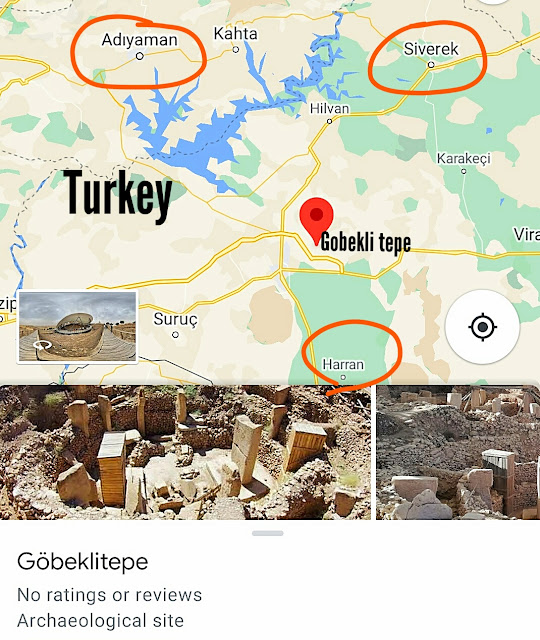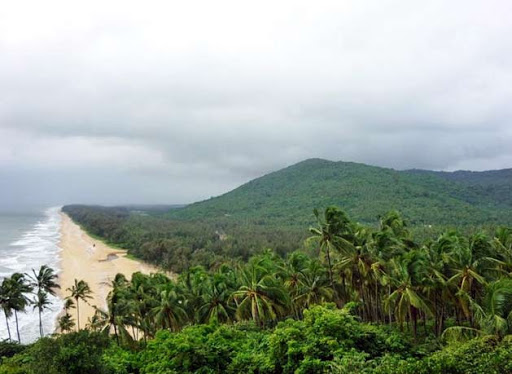Ancient Tamizh kings and Hinduism in Turkey !! - Part 2
In continuation from the previous part of this post,
In the previous part of this post, I have mentioned about tamizh kings in ancient Turkey and few references about Hinduism. In this part, will disclose in detail about Hinduism and Lord Shiva being worshiped by early tamizh people in Turkey.
Why am I referring here as tamizh people ? Why not others who had worshiped Lord Shiva ?? Please read this post completely, to know the answer....
7. Hinduism in Turkey
The famous and the most ancient temple site at Turkey is Gobekli Tepe which was dated back to 10,000 BCE is situated between Adiyaman and Siverek places. Siverek.... Doesn't it sound like Lord Shiva ??
[Note: Not to confuse with Sivi, as Sivi was a great tamizh chola king, who was popularly known as 'Sibi' / 'Sembiyan', who cut and gave his own flesh for a dove. ]
This is not the only place that is named after Lord Shiva, there are many other places in Turkey, which was named after him.
For example: A place in Turkey named 'Harran' in the picture below (Hara Hara Mahadeva !!). Harran was one of the oldest Mesopotamia settlements.
In this place 'Harran', early Mesopotamians built a temple for their moon god called Sin, Sumerians called them as Nanna, which was dated back to 3200 BCE. Recently archaeologists discovered remains of the building in that place.
 |
| Sin - Moon god |
This moon god is seated in a yogic position (Padmanasana), with crescent in the head, humped bull on both the sides. These features are representing Hindu god Lord Shiva. The name of the place Harran, an ancient temple and its remains over there, Sin - Mesopotamian moon god are proving that Lord Shiva was worshiped by the people over there in different names. Continue to read, for more stronger references of Lord Siva being worshiped in Turkey...
Gobekli tepe: This ancient site Gobekli tepe is situated between Adiyaman, Siverek in the west and east and Harran in the south. As this place is surrounded by Hindu places, it is also one of the ancient Hindu temple, particularly temple of Lord Vishnu, from which Varaha avatar of Lord Vishnu was excavated.
Why Varaha avatar of Lord vishnu was engraved in Gobekli tepe ?
Because, the neighbouring country parts of Iran and Iraq was once ruled by Asura king Hiranyaksha. During his rule, it was called as Hiranyapura, in tamizh he was called as 'Iraniyan' and hence his region is now called as 'Iran'. For more details about Hiranyapura, reach out to
At the end of Satya yuga, Lord Vishnu took Varaha (Wild Boar) avatar, killed Hiranyaksha, rescued mother Earth from him and placed Earth in the celestial sphere with an axial tilt of 23.5 degrees. This axial tilt of earth is the reason for us to have different seasons and this determines which part of earth gets maximum sunlight during different period of the year.
Coming back to the topic, Lord shiva was worshiped by tamizh people in Turkey and so many places were named after him. Why was it tamizhs ? can't they be any other people who worshiped Lord Shiva?
To make this point more stronger, I have some more references.
i) Kartikeya:
Son of Lord Shiva, was also called as 'Kandha', 'Murugan' etc. I have already mentioned about worship of Lord Kartikeya / murugan in ancient Iran in my previous post (Part 2 ). Similarly in Turkey, there are many places that are named after Murugan in tamizh. Why he has to be named in tamizh ??
For example, the word komurugan,
In tamizh, Ko - means king
Murugan - means Lord Kartikeya, Son of Lord Shiva
Kartikeya was also popularly called as 'Kandha' , 'Kumara', 'Murugan' etc
ii) Kocali:
What is Kocali that is circled in the picture above and below ??
It refers to the region ruled by Lord Shiva. It was also mentioned in many tamizh literatures and Sivapuranam. Sivapuranam is an ancient tamizh work for Lord Shiva,
In Sivapuranam, there is a line,
கோகழி ஆண்ட குருமணிதன் தாள் வாழ்க
"Kocali anda kuru manithan thaazh vazhga"
meaning, Hail the one who ruled Kocali. Kocali is a tamizh word and that place in turkey is named in tamizh representing Lord Siva's region hence I have mentioned earlier that Lord Shiva was worshiped by tamizhs in Turkey.
8. Cumari
To reiterate the fact that early pandya kings had migrated from Kumari kandam and reached Persian and European nations, there are some references for the same in Turkey. The term Kumari / Cumari has been used in many placed in Turkey and the reason for the etymology for these names are still not decoded by the historians and scholars.
'Yalpanakaya' - the place circled in the above picture refers to 'Yalpanam' place in Sri Lanka and it's named after this place. 'Yal' - means an ancient musical instrument that was originated from ancient tamizhakam.
Before the arrival of Adiyaman King and other Chola kings, early Pandya kings of Kumari kandam had reached Turkey and there are many bull symbols in and around Turkey.
There are more references for that Pandya kings from Kumari Kandam, continue to read...
9. Kanesh, In Persian, it's called as kultepe (meaning: Ash hill). Kanesh, is an archaeological site in Turkey. Isn't it the name Kanesh is similar to Lord Ganesha (First son of Lord Shiva) ?? In tamizh, 'Ka' and 'Ga' will have same letter.
Kultepe consists of a tell, the actual Kultepe and a lower town, where an Assyrian settlement was found. Its name in Assyrian texts from the 2000 BC was Kanesh, the later Hittites mostly called it as Nesa / Nesha. It is also the site of discovery of the earliest traces of the Hittite language, the earliest attestation of any Indo-European language, dated to the 2000 BCE.
The main karum trading was happened at the ancient town of Kanesh. Karum means port in Akkadian and Harbour in Sumerian. This is the name given to ancient Assyrian trade ports in Anatolia in Turkey during 2500 BCE. This is an ancient site of Turkey and contains more information about trading with Mesopotamia, Indus Valley regions and it is the key to unlock many historical secrets of tamizh kings. Details about Kanesh will be published in a separate post.
10. Cappadocia, also known as Katpatuka, Kapadokya is a historical region in Turkey. Cappadocia, was bounded in the south by the chain of the Taurus Mountains that separate it from Cilicia (Original name: Kummani), to the east by the upper Euphrates, to the north by Pontus, and to the west by Lycaonia and eastern Galatia.
This cappadocia is derived from 'Kapadapuram' of tamizhakam, the capital city and busy port city of Pandya kings of second sangam age, which was also submerged later due to frequent major tsunamis. Pearls of Pandya Kapadapuram were of great demand and were highly priced. Cappadocia in Turkey was named after this famous city of tamizhakam, later it was then transformed as 'Kapadokia' / 'Katpatuka'.
Cappadocia was also known as Hatti in the late Bronze Age and was the homeland of the Hittite power centred at Hattusa. The earliest record of the name of Cappadocia dates from the late 6th century BC, when it appears in the trilingual inscriptions of two early Achaemenid kings, Darius I and Xerxes, as one of the countries (Old Persian dahyu) of the Persian Empire. In these lists of countries, the Old Persian name is Katpatuka. It was proposed that Kat-patuka came from the Luwian language, meaning "Low Country". (Kapatapuram was situated at the shore side of southern tamizhakam)
11. Mushika kingdom
The Eastern Mushki people have moved into Cappadocia in the 1200 BCE along with various Sea Peoples.
Who were Mushiki ???
The Mushkis were a Thraco-Phrygian group people, whose kingdom in the west central part of Anatolia, in what is now Asian Turkey, centred on the Sangarios River. Phrygian spoke an Indo - European language. The inscriptions found at Gordium make clear that Phrygians spoke an Indo-European language with at least some vocabulary similar to Greek. Phrygian clearly did not belong to the family of Anatolian languages.
Scholars clarifies the etymology of the name mushiki, "Mush" as meaning "worker" or "agriculturalist."
This is a wrong!!
Mushki is a sanskrit term, Mushki refers to Mushika / Mushaka kingdom of ancient tamizhakam. It was a minor dynasty kings who took power over the region in and around Mushika mountain / Mount Eli, which is situated in present-day Kerala, south India. Thus they were called as Mushika, who went to western side to rule Turkey and other regions..
1. Why tamizh kings were named as Mushika in sanskrit ?
Mushika is a sanskrit word meaning rats. Rats are called as 'Eli', in tamil and the mountain is called as Elimalai.
But, the truth is, that mountain is not ELIMALAI, it's original name is 'EZHILMALAI'.
In tamizh, Ezhil - means beautiful,
kunram / malai - means mountain, together it means - beautiful mountain.
Ezhil (எழில்) malai - (beautiful mountain) was incorrectly pronounced as Eli (எலி) malai (Rat mountain), by using wrong 'la' letter. Then, with the same meaning it was translated into sanskrit as 'Mushika' and the kings who ruled over the region were called as 'Mushika dynasty of kings'.
Early Tamizh poems contain several references about Ezhilmalai. The early historic Ezhimala clan had matrimonial alliances with the Chera, Pandya and Chola chieftains.
Ancient Tamil poems also describe the velir-level chiefdom of Ezhilmalai on the northern edge of Tamilakam on its west (Malabar) coast. The rulers of Ezhilmalai were the most prominent hill chieftains of ancient Kerala. The port known as Naravu was located in Ezhimalai chiefdom (Akam, 97).
2. Why did Mushika kings go to Turkey ? Only to explore and expand?
Simple answer to this is, 'What comes around, goes around !!'.
The origin of Mushika dynasty was tracing back to descent of 'Heheya' queen, whose family was killed during Parashurama's slaughter of Kshatriya rulers.
'Heheya' - refers to 'Kekeya' kingdom during the period of Ramayana. Kaikeyi (mother of Bharatha) was the princess of Kekaya kingdom. Kekeya kingdom was situated at the far western side of Akand bharat, i.e near Caucasus mountain and their kingdom covers Turkey, Georgia, Armenia and Azerbaijan.
Thus, Mushika kings of Ezhil malai, went back to their ancestor place - Kekeya kingdom (Modern Greece, Turkey and Georgia) in the same name as Mushki kings.
So, did tamizh people was there in Greece, Georgia and Azerbaijan as well ??? Yes, ancient tamizh people were there in European nations...
One hint for the same,
Comana (Komana Pontika) was an ancient city of Cappadocia, frequently called as Comana Chryse i.e. "the golden"( to distinguish it from Comana in Pontus). Isn't this name referring to Ko-manna (King) + Pontika (Pandya was called as Pontika in Greece) ???
More truths about tamizh society in European countries will be unraveled in Kumari kandam - part 7 post....












Now i know the true meaning behind the name Elimalai.
ReplyDelete